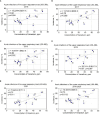The incidence of upper respiratory infections in children is related to the concentration of vanadium in indoor dust aggregates
- PMID: 38577275
- PMCID: PMC10993999
- DOI: 10.3389/fpubh.2024.1339755
The incidence of upper respiratory infections in children is related to the concentration of vanadium in indoor dust aggregates
Abstract
Background: It has been reported that the disease-initiated and disease-mediated effects of aerosol pollutants can be related to concentration, site of deposition, duration of exposure, as well as the specific chemical composition of pollutants.
Objectives: To investigate the microelemental composition of dust aggregates in primary schools of Vilnius and determine trace elements related to acute upper respiratory infections among 6-to 11-year-old children.
Methods: Microelemental analysis of aerosol pollution was performed using dust samples collected in the classrooms of 11 primary schools in Vilnius from 2016 to 2020. Sites included areas of its natural accumulation behind the radiator heaters and from the surface of high cupboards. The concentrations of heavy metals (Pb, W, Sb, Sn, Zr, Zn, Cu, Ni, Mn, Cr, V, and As) in dust samples were analyzed using a SPECTRO XEPOS spectrometer. The annual incidence rates of respiratory diseases in children of each school were calculated based on data from medical records.
Results: The mean annual incidence of physician-diagnosed acute upper respiratory infections (J00-J06 according to ICD-10A) among younger school-age children was between 25.1 and 71.3% per school. A significant correlation was found between vanadium concentration and the number of episodes of acute upper respiratory infections during each study year from 2016 to 2020. The lowest was r = 0.67 (p = 0.024), and the highest was r = 0.82 (p = 0.002). The concentration of vanadium in the samples of dust aggregates varied from 12.7 to 52.1 parts per million (ppm). No significant correlations between the other trace elements and the incidence of upper respiratory infections were found, which could be caused by a small number of study schools and relatively low concentrations of other heavy metals found in the samples of indoor dust aggregates.
Conclusion: A significant and replicable correlation was found between the concentration of vanadium in the samples of natural dust aggregates collected in primary schools and the incidence of acute upper respiratory infections in children. Monitoring the concentration of heavy metals in the indoor environment can be an important instrument for the prevention and control of respiratory morbidity in children.
Keywords: children; dust aggregates; microelemental composition; primary school; respiratory infections; vanadium.
Copyright © 2024 Prokopciuk, Taminskiene, Vaideliene, Juskiene, Svist, Valiulyte, Valskys, Valskiene, Valiulis, Aukstikalnis, Vaidelys, Butikis, Norkuniene, Tarasiuk and Valiulis.
Conflict of interest statement
The authors declare that the research was conducted in the absence of any commercial or financial relationships that could be construed as a potential conflict of interest.
Figures


Similar articles
-
Hair geochemical composition of children from Vilnius kindergartens as an indicator of environmental conditions.Environ Geochem Health. 2018 Oct;40(5):1817-1840. doi: 10.1007/s10653-017-9977-7. Epub 2017 May 23. Environ Geochem Health. 2018. PMID: 28536963
-
Pollution evaluation, human health effect and tracing source of trace elements on road dust of Dhanbad, a highly polluted industrial coal belt of India.Environ Geochem Health. 2021 May;43(5):2081-2103. doi: 10.1007/s10653-020-00785-y. Epub 2021 Jan 3. Environ Geochem Health. 2021. PMID: 33389370
-
Dust is the dominant source of "heavy metals" to peat moss (Sphagnum fuscum) in the bogs of the Athabasca Bituminous Sands region of northern Alberta.Environ Int. 2016 Jul-Aug;92-93:494-506. doi: 10.1016/j.envint.2016.03.018. Epub 2016 May 10. Environ Int. 2016. PMID: 27177217
-
Pollution status and human health risk assessments of selected heavy metals in urban dust of 16 cities in Iran.Environ Sci Pollut Res Int. 2020 Jun;27(18):23094-23107. doi: 10.1007/s11356-020-08585-8. Epub 2020 Apr 24. Environ Sci Pollut Res Int. 2020. PMID: 32329009 Review.
-
Distribution, sources and health risks of heavy metals in indoor dust across China.Chemosphere. 2023 Feb;313:137595. doi: 10.1016/j.chemosphere.2022.137595. Epub 2022 Dec 20. Chemosphere. 2023. PMID: 36563718 Review.
Cited by
-
The role of sodium pyruvate in mitigating the cytotoxic effects of vanadium on CHO-K1 cells.Sci Rep. 2025 Jul 5;15(1):24006. doi: 10.1038/s41598-025-09606-7. Sci Rep. 2025. PMID: 40615457 Free PMC article.
References
-
- Valiulis A, Bousquet J, Veryga A, Suprun U, Sergeenko D, Cebotari S, et al. . Vilnius declaration on chronic respiratory diseases: multisectoral care pathways embedding guided self-management, mHealth and air pollution in chronic respiratory diseases. Clin Transl Allergy. (2019) 9:7. doi: 10.1186/s13601-019-0242-2, PMID: - DOI - PMC - PubMed
Publication types
MeSH terms
Substances
LinkOut - more resources
Full Text Sources
Research Materials

